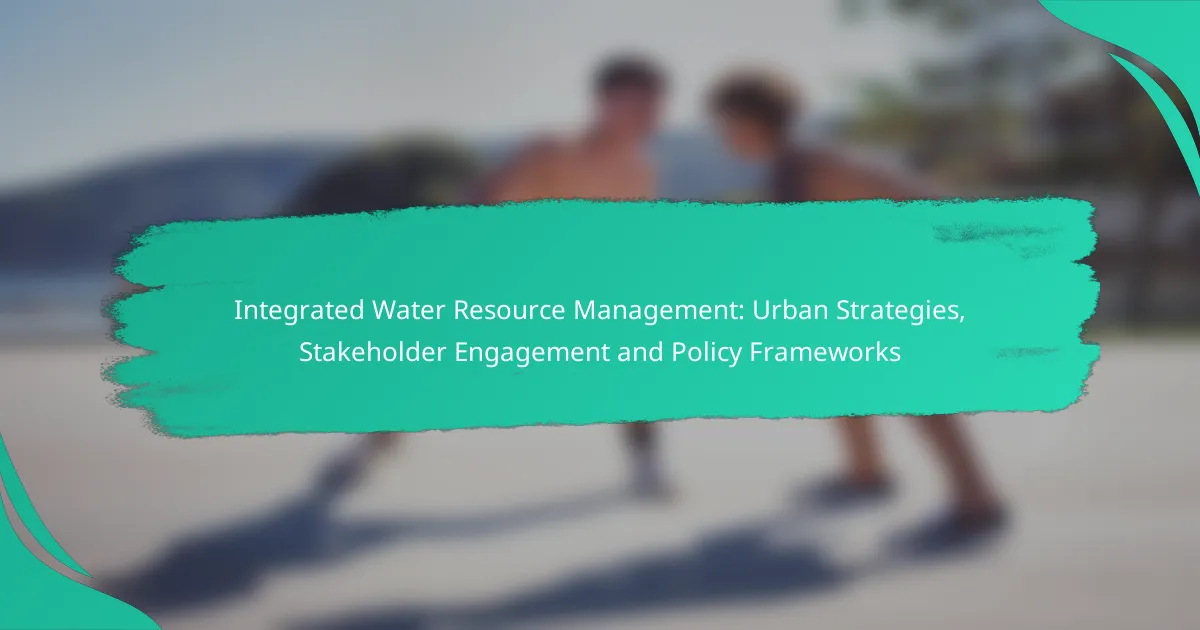Integrated Water Resource Management (IWRM) is essential for developing urban strategies that promote sustainable water practices while addressing the challenges of supply, quality, and demand. By actively engaging stakeholders, including government entities and local communities, IWRM fosters collaboration that leads to more effective and accepted water management solutions. Supported by comprehensive policy frameworks, these strategies ensure the sustainable use of water resources and enhance resilience to climate change impacts.
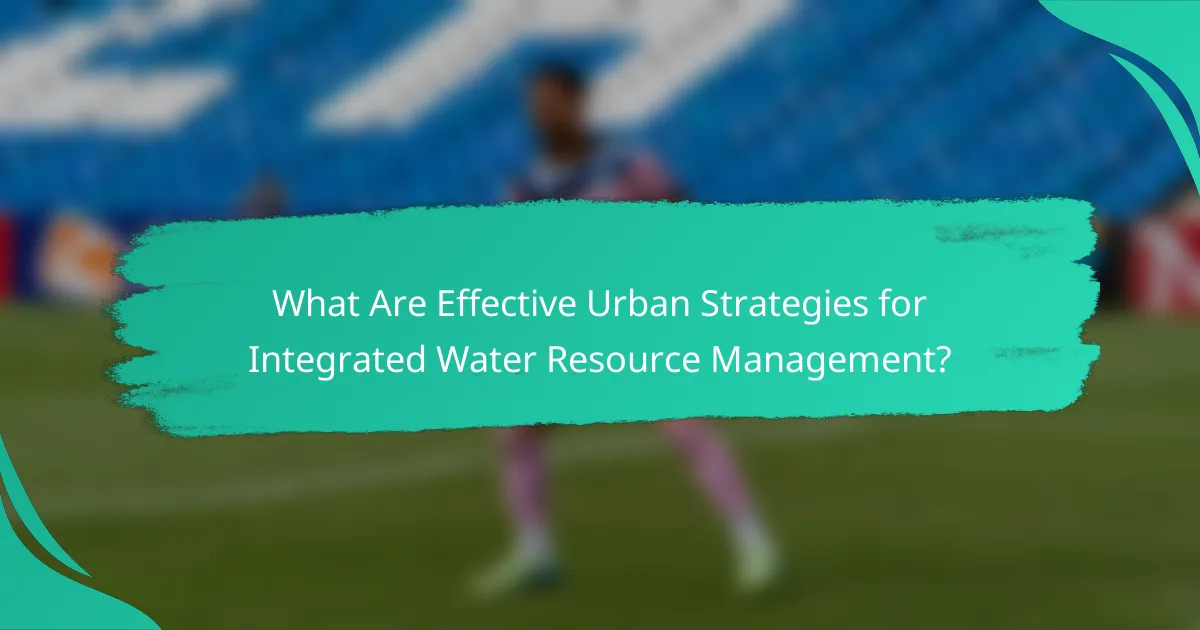
What Are Effective Urban Strategies for Integrated Water Resource Management?
Effective urban strategies for Integrated Water Resource Management (IWRM) focus on sustainable practices that balance water supply, quality, and demand while engaging stakeholders. These strategies aim to optimize water usage, reduce waste, and enhance resilience against climate change impacts.
Green Infrastructure
Green infrastructure incorporates natural processes to manage water resources effectively. Techniques such as green roofs, permeable pavements, and rain gardens help absorb rainfall, reduce runoff, and improve water quality. Cities can enhance biodiversity and mitigate urban heat effects while simultaneously managing stormwater.
Implementing green infrastructure often requires collaboration among urban planners, environmentalists, and local communities. Local governments should consider incentives for property owners to adopt these practices, as they can significantly lower municipal stormwater management costs.
Stormwater Management Systems
Stormwater management systems are designed to control and treat runoff from urban areas. These systems can include retention basins, detention ponds, and constructed wetlands that capture and filter stormwater before it enters natural waterways. Properly designed systems can reduce flooding and improve water quality.
When planning stormwater systems, cities should assess local topography and soil conditions to determine the most effective solutions. Regular maintenance and monitoring are crucial to ensure these systems function optimally and meet regulatory standards.
Water Recycling Programs
Water recycling programs treat wastewater for reuse, significantly reducing the demand for freshwater resources. These programs can provide reclaimed water for irrigation, industrial processes, or even potable use, depending on treatment levels. Implementing such programs can alleviate pressure on water supplies, especially in drought-prone areas.
To establish effective water recycling initiatives, cities should engage stakeholders, including residents and businesses, to promote acceptance and participation. Regulatory frameworks must also be adapted to ensure safety and public health standards are met.
Smart Water Metering
Smart water metering involves using advanced technology to monitor water usage in real-time. These systems can provide consumers with detailed insights into their water consumption patterns, helping to identify leaks and promote conservation. Smart meters can also assist utilities in managing supply more efficiently.
When implementing smart metering, municipalities should consider the costs of installation and maintenance versus the potential savings from reduced water loss. Public education campaigns can enhance user engagement and encourage responsible water use.
Urban Planning Integration
Integrating water resource management into urban planning ensures that water considerations are part of land use decisions. This approach promotes sustainable development by aligning infrastructure investments with water conservation goals. Effective integration can lead to more resilient urban environments capable of adapting to climate change.
Urban planners should collaborate with water management authorities to develop comprehensive plans that address both current and future water needs. Engaging the community in the planning process can foster support and ensure that local needs and values are reflected in the strategies adopted.
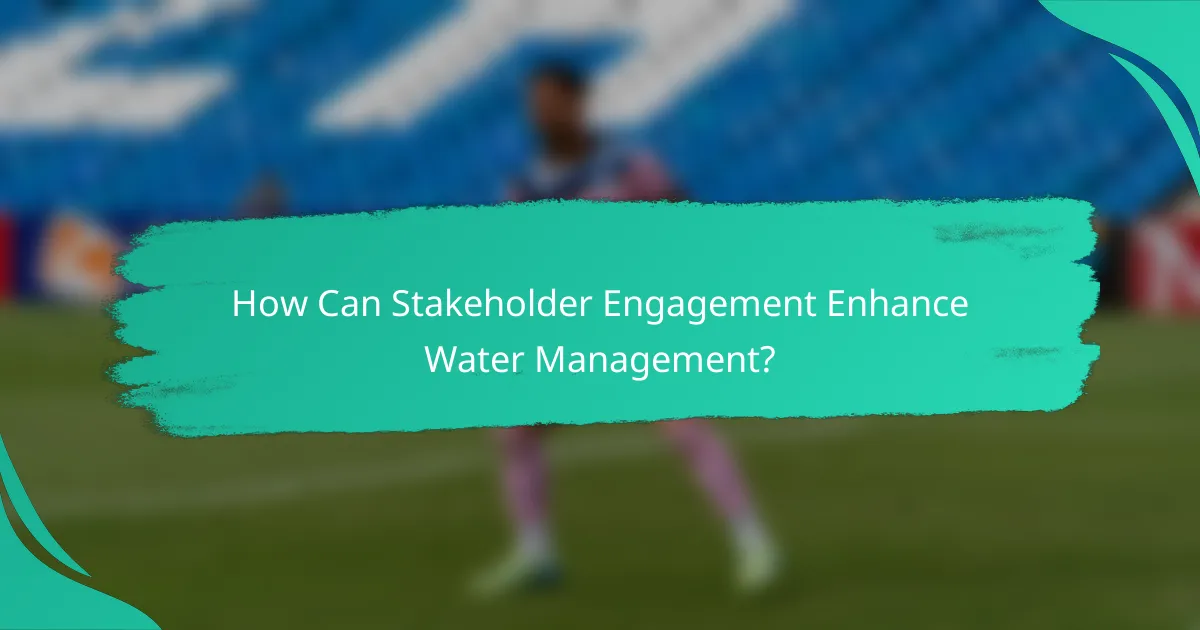
How Can Stakeholder Engagement Enhance Water Management?
Stakeholder engagement is crucial for improving water management by fostering collaboration among various groups, including government bodies, local communities, and private entities. Effective engagement ensures that diverse perspectives are considered, leading to more sustainable and accepted water resource strategies.
Community Involvement Initiatives
Community involvement initiatives empower local residents to participate in water management decisions. These programs can include educational workshops, volunteer clean-up events, and citizen advisory boards that allow community members to voice their concerns and suggestions.
For example, a city might organize regular town hall meetings to discuss water quality issues, providing a platform for residents to share their experiences and propose solutions. Engaging the community helps build trust and encourages collective responsibility for local water resources.
Public-Private Partnerships
Public-private partnerships (PPPs) leverage the strengths of both sectors to enhance water management. These collaborations can lead to innovative solutions, such as financing infrastructure projects or developing new technologies for water conservation.
For instance, a municipality might partner with a private company to implement a smart water metering system, improving efficiency and reducing waste. Successful PPPs require clear agreements on roles, responsibilities, and profit-sharing to ensure mutual benefits.
Stakeholder Workshops
Stakeholder workshops are structured meetings that bring together various parties involved in water management. These workshops facilitate dialogue, allowing stakeholders to discuss challenges, share knowledge, and brainstorm solutions collaboratively.
Workshops can be particularly effective for addressing specific issues, such as flood management or water quality improvement. By creating a safe space for discussion, these gatherings can lead to actionable strategies that reflect the needs and priorities of all stakeholders involved.
Feedback Mechanisms
Feedback mechanisms are essential for evaluating the effectiveness of water management strategies. These can include surveys, suggestion boxes, and online platforms where stakeholders can provide input on policies and initiatives.
For example, a city might implement an online portal for residents to report water issues or suggest improvements. Regularly collecting and analyzing feedback helps organizations adapt their approaches and ensures that stakeholder concerns are addressed in a timely manner.
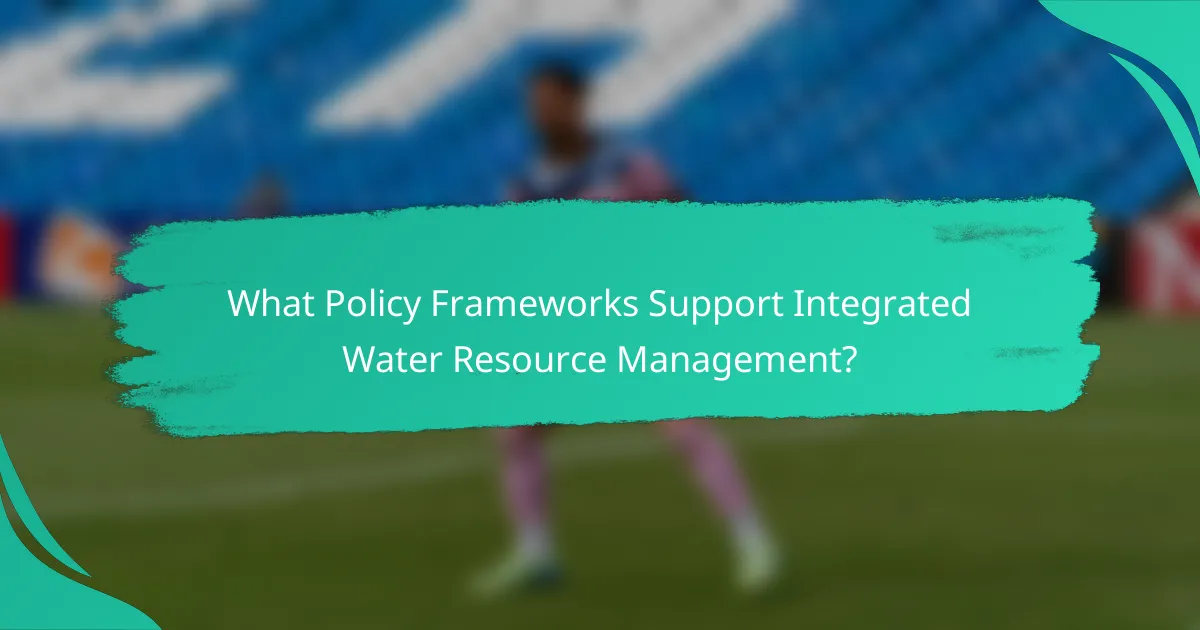
What Policy Frameworks Support Integrated Water Resource Management?
Integrated Water Resource Management (IWRM) is supported by various policy frameworks that ensure sustainable water use, promote stakeholder engagement, and facilitate effective governance. These frameworks often include regulatory compliance standards, incentive programs, and mechanisms for cross-jurisdictional cooperation.
Regulatory Compliance Standards
Regulatory compliance standards are essential for enforcing water management practices that protect resources and public health. These standards often include limits on pollutants, requirements for water quality monitoring, and guidelines for water usage efficiency. For instance, the Clean Water Act in the United States sets benchmarks for water quality that municipalities must adhere to.
Local governments should regularly review and update their compliance standards to reflect current scientific understanding and technological advancements. Engaging with stakeholders during this process can enhance transparency and foster community support.
Incentive Programs for Sustainable Practices
Incentive programs encourage businesses and individuals to adopt sustainable water practices through financial or technical support. These may include grants, tax breaks, or subsidies for implementing water-saving technologies like rainwater harvesting systems or efficient irrigation methods. For example, many states in the U.S. offer rebates for homeowners who install water-efficient appliances.
To maximize participation, programs should be well-publicized and easy to access. Providing clear guidelines and success stories can motivate stakeholders to engage in sustainable practices and contribute to overall water resource management goals.
Cross-Jurisdictional Cooperation
Cross-jurisdictional cooperation is crucial for effective IWRM, especially in regions where water sources span multiple administrative boundaries. Collaborative efforts can lead to shared resources, coordinated policies, and unified management strategies. For example, river basin management organizations often bring together various stakeholders to address water quality and quantity issues collectively.
Establishing formal agreements and communication channels among jurisdictions can enhance cooperation. Regular meetings and joint initiatives can help align goals and foster a sense of shared responsibility for water resources.

What Are the Challenges in Implementing Integrated Water Resource Management?
Implementing Integrated Water Resource Management (IWRM) faces several significant challenges that can hinder effective water governance. Key obstacles include funding limitations, data management issues, and political resistance, each of which can impede the development of sustainable urban water strategies.
Funding Limitations
Funding limitations are a primary challenge in executing IWRM initiatives. Many urban areas struggle to secure adequate financial resources for infrastructure projects, maintenance, and technology upgrades. This often results in underfunded programs that cannot meet the growing demands for water services.
To address funding issues, stakeholders can explore diverse financing options, such as public-private partnerships, grants, and international aid. Establishing clear budgets and prioritizing projects based on urgency and impact can also help maximize available funds.
Data Management Issues
Data management issues significantly affect the implementation of IWRM by limiting access to reliable and comprehensive water data. In many cases, data is fragmented across different agencies, making it difficult to analyze and share information effectively. This lack of coordination can lead to inefficient resource allocation and decision-making.
To improve data management, cities should invest in centralized data systems that integrate information from various sources. Regular training for staff on data collection and analysis can enhance the quality of data and ensure that stakeholders have access to the information needed for informed decision-making.
Political Resistance
Political resistance can severely obstruct the implementation of IWRM strategies. Stakeholders may face opposition from local governments or interest groups that prioritize short-term gains over long-term sustainability. This resistance can manifest in the form of regulatory hurdles or lack of support for necessary policy changes.
Engaging stakeholders through transparent communication and inclusive decision-making processes can help mitigate political resistance. Building coalitions among diverse groups, including community members, businesses, and environmental organizations, can create a unified front that advocates for effective water management policies.
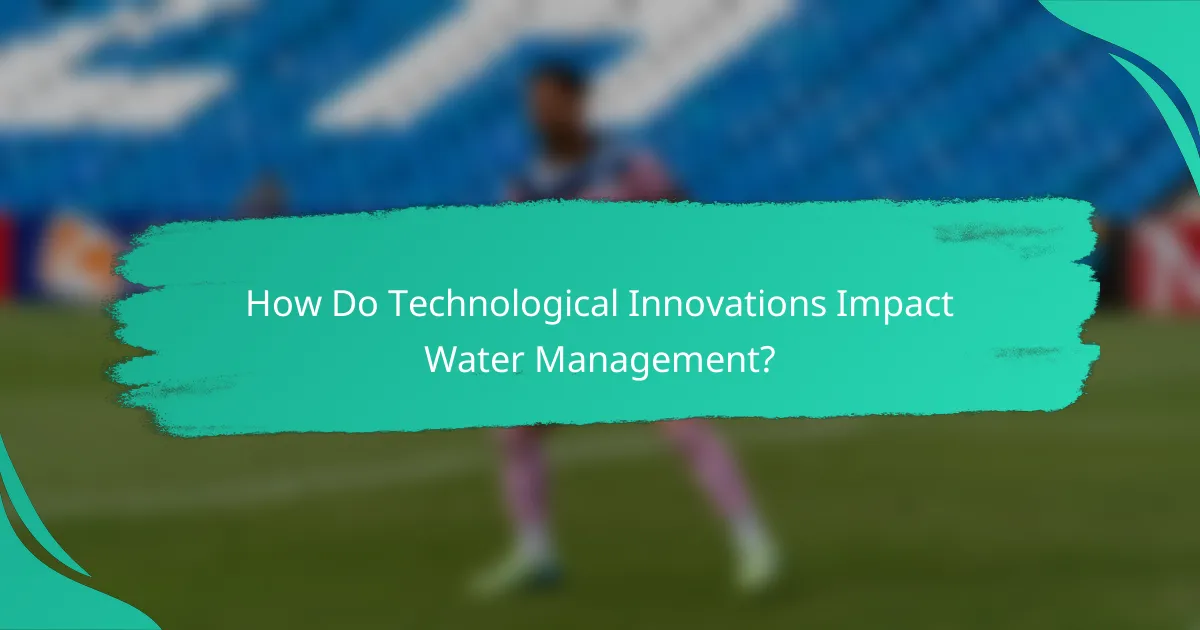
How Do Technological Innovations Impact Water Management?
Technological innovations significantly enhance water management by improving efficiency, accuracy, and stakeholder engagement. These advancements streamline processes, optimize resource allocation, and facilitate real-time monitoring and decision-making.
IoT Solutions for Monitoring
Internet of Things (IoT) solutions enable continuous monitoring of water resources through connected devices that collect and transmit data. These sensors can track parameters such as water quality, flow rates, and usage patterns, providing actionable insights for urban planners and water managers.
For example, smart meters can detect leaks in real-time, allowing for quick repairs and reducing water loss. Cities implementing IoT solutions often see a reduction in operational costs and improved service delivery.
Data Analytics for Decision Making
Data analytics plays a crucial role in transforming raw data from IoT devices into meaningful insights for effective water management. By analyzing trends and patterns, decision-makers can forecast demand, identify inefficiencies, and develop targeted strategies for resource allocation.
Using predictive analytics, water authorities can anticipate peak usage times and adjust supply accordingly, which is particularly important in regions facing water scarcity. Implementing data-driven decision-making processes can lead to more sustainable and resilient urban water systems.
